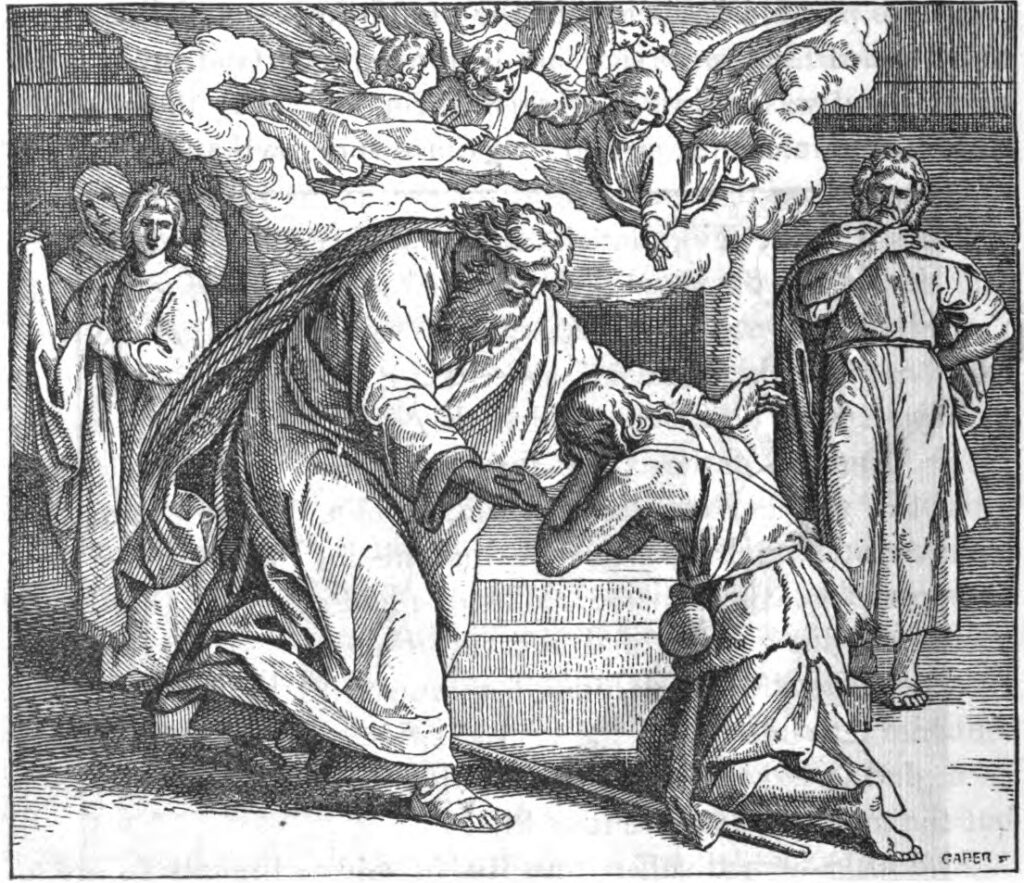“I heard the voice of the Lord, saying, Whom shall I send, and who will go for us? Then said I, Here am I; send me. And he said, Go, and tell this people, Hear ye indeed, but understand not; and see ye indeed, but perceive not. Make the heart of this people fat, and make their ears heavy, and shut their eyes; lest they see with their eyes, and hear with their ears, and understand with their heart, and convert, and be healed. Then said I, Lord, how long? And he answered, Until the cities be wasted without inhabitant, and the houses without man, and the land be utterly desolate, And the LORD have removed men far away, and there be a great forsaking in the midst of the land” (Isaiah 6:8-12).
This was God’s message to Isaiah upon his commission to become the prophet to the two Hebrew kingdoms in the generation when Assyria successfully conquered Israel and unsuccessfully attempted to conquer Judah. These two kingdoms, rooted in two separate houses (Leah’s and Rachel’s: Ruth 4:11) emerged at the very beginning of the twelve-tribe people-group called the Hebrews. At the time of the above Isaiah passage, the two houses/kingdoms were at war with each other – during which crisis the Judeans were called “Jews” for the very first time, specifically to distinguish them from the Israelites (2 Kings 16:6).
There would be a near-term “partial fulfillment” of the Isaiah 6:8-12 prophecy (perhaps better characterized as an “iteration of the desolation-of-Jerusalem Biblical pattern”) in the Babylonian conquest of Judah a century and a half later, and another partial fulfillment by the Romans in 70AD following the earthly ministry of Our Lord, and then a final and complete fulfilment in 135AD when the Romans expelled ALL Jews from the Holy Land “forever” and renamed it Syriac Palestine following the Simon bar Kokhbar revolt. That desolation of the land ended formally only in 1917 when the British Empire (at the height of the influence of Christian and Jewish Millennialists and the doctrine of British Israelism) liberated the Holy Land (by military conquest) from the Ottoman Turks and essentially gifted it to the Jews per the Balfour Declaration.
When Jesus began His ministry in Galilee of the Gentiles, the former territory of the Kingdom of Israel, He made it very clear that “I was sent only to the lost sheep of the house of Israel” (Matt 15:24) which was a prophetically important restatement of the limitation He imposed when He sent out “The Twelve” (Matt 10:5-6). The number of that first group of envoys was twelve because both Hebrew houses by this time included members of all twelve tribes, but the distinction between the two houses remained because the House of Israel had been “divorced” by God and went fully pagan, while the House of Judah had not (Jeremiah 3, especially verse 8, Hosea 1-3).
Having fulfilled various key prophecies by giving the genetic descendants of the House of Israel “first dibs” on salvation in His name, Jesus then broadened the franchise to “all the families of the earth” (Genesis 12:3), by sending out “The Seventy” (numerologically representative of the Table of Nations of Genesis 10: the 70 patriarchs descended from Noah). ALL who accept salvation in Christ from that day to this become a part of the “Bride of Christ” awaiting reunification with God through the Wedding Feast of the Lamb – fulfilling the promise of God to nullify the divorce by He Himself (the husband) dying on the cross to release the wife to remarry without violating the unbreakable law of Jeremiah 3:1.
Regarding salvation, the Jews were a special case, however, because authentic Torah-based Judaism implicitly assumed that the House of Judah would recognize its Messiah when He came: all the Biblical writings and rituals had been designed to prepare them for that. But Judaism had been severely corrupted in the years immediately preceding His first coming: the Jewish political world had been hijacked by the Edomite false-Jew Herod the Great (who, with Roman backing, had slaughtered the entire Hasmonean royal family (the descendants of the righteous Judah Maccabee who had overthrown the Antichrist figure Antiochus IV Epiphanes of Daniel 11). And internally, the cult of hyper-legalism called Phariseeism dominated Judaism. But because the House of Judah never ended and remains “married to God” to this day under the Old Covenant, there remains hope for the collective salvation of the Jews until the Second Coming – a doctrine that is detailed and reaffirmed by Paul in Romans 11.
All of this is enormously important in understanding why Jesus invoked Isaiah 6:9-10 in Mark 4:11-12, saying
“The mystery of the kingdom of God has been given to you, but to those on the outside everything is expressed in parables, so that, ‘they may be ever seeing but never perceiving, and ever hearing but never understanding; otherwise they might turn
and be forgiven.’ ”
“Those on the outside” were (and are) those who, because of lack of cultural familiarity and/or spiritual discernment, could not recognize the teachings of the Tanach (Old Testament) which His parables conveyed in the form of symbols, metaphors and textual landmarks. Most Herodians, Pharisees and Non-Hebrews did not understand the hidden deeper meaning of the parables, even if they understood the surface meaning.
The best modern example of “seeing without perceiving” in Christendom is the parable that most closely fits the theme of “sibling rivalry” in Isaiah 6:8-12: the Parable of the Prodigal Son.
The surface meaning of the Prodigal Son parable happens to be one of the most profound truths of Christianity: that God welcomes back repentant sinners no matter how far they have fallen away from Him. The very clarity of this powerful message of God’s grace and mercy makes it the perfect cover for a deeper meaning that only Christ’s disciples and Torah-faithful Hebrews would have understood. But importantly, the surface meaning is not in the slightest degree diminished by the deeper message, a fact that is critical to remember when grappling with the revelation highlighted below.
Before I reveal it let me remind you that many Bible truths do not fit the Hellenic linear, two-dimensional perspective on Bible verses/passages which insists “either this/or that must be true exclusively.” In contrast, the Hebrew multi-dimensional perspective correctly recognizes “both this/and that can be simultaneously true.”
So, what is the deeper message hidden in plain sight in the Parable of the Prodigal Son?
“Very simply, the father in the parable is God. The older son is Judah, and the younger (prodigal) son is Joseph. These are the two actual sons of Jacob’s wives Leah and Rachel, respectively, the human roots of the two houses and later two kingdoms of Judah and Israel. Joseph, who is represented by his son Ephraim among the twelve tribes (as the symbolic head of the House of Israel per Jeremiah 31:9), led his house into idolatrous rebellion against God so egregiously that God “divorced” the House of Israel and sent him/them away to live among the Gentiles. God then made a way for Israel to be restored that simultaneously opened the door to salvation for the Gentiles.
To allay any doubt of His intended meaning (to the alert Hebrew listeners), Jesus designed the parable to directly connect the metaphorical redemption/restoration of the specially favored “Prodigal Son” in the parable with the historical restoration/restoration of the actual specially favored son of Jacob: Joseph (the patriarch of the House of Israel) by the Egyptian Pharaoh in Genesis 41. Note especially the symbolic significance of the robe (royal authority) and ring (lawmaking power) in the Genesis account, and of the sandals (ownership of land) in Ruth 4:7.
The Parable of the Prodigal Son is in actuality a summary of one two house prophecy of the reunification of the two Hebrew houses in the Millennial Kingdom. That doctrinal theme not only dominates several of the Bible’s prophetic books and is heavily interwoven throughout entire Old Testament, it is also subtly referenced in numerous books of the New Testament. Only those whose spiritual eyes have been opened to the historical and prophetic significance of the two house teaching will recognize it, but once the blinders of unfamiliarity are removed the truth about the two house doctrine is impossible to “un-see.” There is obviously much more to the doctrine than this brief article can relate, but it is likely that you, reader, will now begin recognizing two house passages whenever you read your Bible and be amazed that you never previously realized they were there or how central they are to Christianity.
For more on this topic read my book The Prodigal Son Prophecy.
###
This article is a revised and updated version of an article published in October of 2019 under a similar title.




